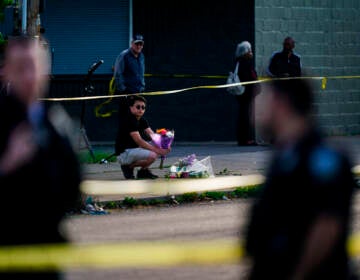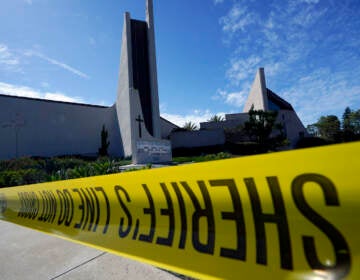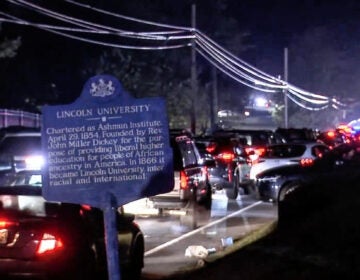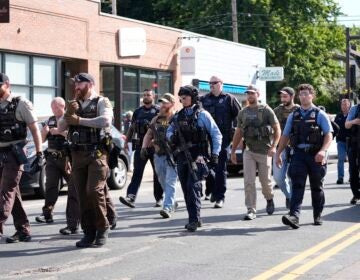Police: Buffalo gunman aimed to keep killing if he got away
The revelation raised questions over missed opportunities to put a potential mass shooter under closer scrutiny or make sure he didn’t have access to deadly firearms.
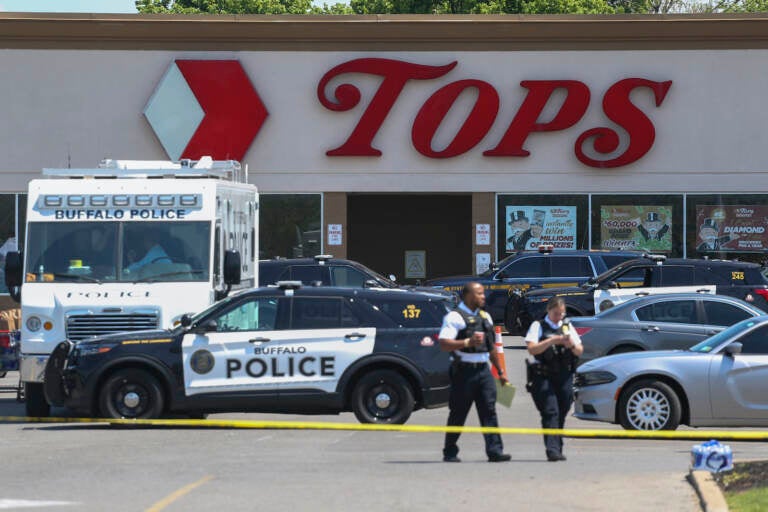
Police walk outside the Tops grocery store following a mass shooting on Sunday, May 15, 2022, in Buffalo, N.Y. (AP Photo/Joshua Bessex)
The white gunman accused of a racist rampage at a Buffalo supermarket planned to keep killing if he had escaped the scene, the police commissioner said Monday, as authorities investigated the massacre of 10 Black people as a potential hate crime or act of domestic terrorism.
The gunman, who had crossed the state to target people at the Tops Friendly Market, had talked about shooting up another store as well, Buffalo Police Commissioner Joseph Gramaglia told CNN.
“He was going to get in his car and continue to drive down Jefferson Avenue and continue doing the same thing,” the commissioner said.
The commissioner’s account was similar to portions of a racist 180-page document, purportedly written by Payton Gendron, that said the assault was intended to terrorize all nonwhite, non-Christian people and get them to leave the country. Federal authorities were working to confirm the document’s authenticity.
Saturday’s bloodshed in Buffalo was the deadliest in a wave of weekend shootings, including at a California church and a Texas flea market.
Gendron, 18, traveled about 200 miles (320 kilometers) from his home in Conklin, New York, to commit the attack, police said. He wore body armor and used a helmet camera to livestream the bloodbath on the internet.
Law enforcement officials said Sunday that New York State Police troopers had been called to Gendron’s high school last June for a report that the then-17-year-old had made threatening statements.
The disclosure raised questions about whether his encounter with police and the mental health system was yet another missed opportunity to put a potential mass shooter under closer law enforcement scrutiny, get him help or make sure he didn’t have access to guns.
Gendron had threatened to carry out a shooting at Susquehanna Valley High School in Conklin around graduation, a law enforcement official who spoke on condition of anonymity said. The official was not authorized to speak publicly about the investigation.
Gramaglia said Gendron had no further contact with law enforcement after a mental health evaluation that put him in a hospital for a day and a half.
“Nobody called in. Nobody called any complaints,” Gramaglia said. The threat was “general” in nature, he said, and not related to race.
New York is one of several states that have enacted “red flag” laws in recent years to try to prevent mass shootings by identifying people who show signs that they might be a threat to themselves or others.
Those laws allow law enforcement officers, a person’s family, or in some cases medical professionals or school officials to petition courts to seize the person’s guns temporarily or prevent the individual from buying weapons.
Federal law bars people from owning guns if a judge has determined they have a “mental defect” or they have been forced into a mental institution. An evaluation alone would not trigger the prohibition.
It is unclear whether officials could have invoked the “red flag” regulation after the high school incident. Police and prosecutors wouldn’t provide details on the incident or say when Gendron had acquired the weapons used in the deadly attack.
The long list of mass shootings in the U.S. involving missed opportunities to intervene includes the 2018 massacre of 17 students at a high school in Parkland, Florida, where law enforcement officials had received numerous complaints about the gunman’s threatening statements, and the killings of more than two dozen people at a Texas church in 2017 by a former Air Force member who was able to buy a gun despite a history of violence.
The victims in Buffalo included an 86-year-old woman who had just visited her husband in a nursing home, a man buying a cake for his grandson, a church deacon helping people get home with their groceries and a supermarket security guard.
At the White House, President Joe Biden paid tribute to one of the victims, security guard and retired police officer Aaron Slater.
Biden, who planned to visit Buffalo on Tuesday, said Salter “gave his life trying to save others” at the supermarket. Salter fired repeatedly at the attacker, striking his armor-plated vest at least once before being shot and killed.
Authorities said all 10 of those who died were Black, while three other people were wounded: one Black, two white.
Gendron researched the neighborhood’s demographics and conducted reconnaissance before the attack, investigators said. Mayor Byron Brown said the gunman “came here with the express purpose of taking as many Black lives as he possibly could.”
Most of the victims were elders, a distinction that historically carries weight in Black communities. The same was true for several of the nine Black people killed in 2015 at racist attack at a historic Black church in Charleston, South Carolina.
The Buffalo gunman livestreamed the attack on Twitch, prompting scrutiny of how fast social platforms react to violent videos.
Portions of the video circulating online showed the gunman killing multiple shoppers in less than a minute. At one point, he trains his weapon on a white person cowering behind a checkout counter, but says, “Sorry!” and doesn’t shoot. Screenshots purporting to be from the broadcast appear to show a racial slur against Black people scrawled on his rifle.
Gendron surrendered to police who confronted him in the supermarket’s vestibule. He was arraigned on a murder charge. Relatives didn’t respond to messages.
___
Associated Press reporters Dave Collins in Hartford, Connecticut; Robert Bumsted in Buffalo; Michael Hill in Albany, New York, Travis Loller in Nashville and Jake Bleiberg in Dallas contributed reporting. Balsamo reported from Washington.
WHYY is your source for fact-based, in-depth journalism and information. As a nonprofit organization, we rely on financial support from readers like you. Please give today.


